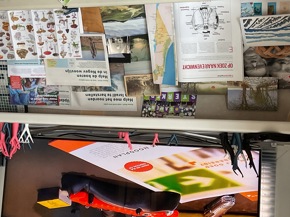38818BH11 ’t Mooist aan myDi is dat je er alles in
IN KWIJTKUNT WAARMEE
WAAR JE ALSMAAR WEER MEE VOLZIT
ZO NU ÈN DAN, tussen neus & lippen, kop & kont,
kippen & hanen! In die zin heeft ‘t ook veel wèg van de jaarlijkse kalenderhappenings
tussen nieuwjaarsdag & de daarop volgende oudejaarsdag, de babies, de bejaarden, de sinterklazen
èn schoorsteenvegende pietjes, de wereldwijde speeltuin & èn ‘t varenveld!!!! De Zevende Dag, Pasen, Pinksteren, Verzoendagen, Loof-hutten, Lichtfeesten, Poeriem &
al wat boeit?!
TAVERNACLES/SOEKKOT/LOOFHUTTENFEEST: ~ 15th
to 22nd Tishri (Sept./Oct.) ~ Originally it was the third of the Harvest Festivals,
when the fruit offerings were brought tot the Temple. It is the only one which is still observed
primarily as a Harvest Festival... ~ Ceremonial observance ~ CONGREGANTS BRING FRUIT
TO THE SYNAGOGUE WHERE A SUKKAH (Or BOOTH) is erected. The ceiling of this booth is made
of interlocking twigs & greenery open to the sky and from it
hang various types of fruit!
The Congregation adjourn
into this Booth for KIDDUSH after the Services during this festival!
This Booth, while reminding us of the need to thank “G D” for all abundant gifts of Nature, also reminds us of the impermanence of Life & òf Our NEED to place
our trust in ‘G d’...
Historically,
the Booth reminds us
how the ancient Israelites dwelt in Booths
as they travelled through the desert, as well as recalling how in later times they lived in Tents
when they crowded into Yerusjalayim to observe this Festival. Usually, in the Synagogue service
a LULAV (consisting of palm, myrtle & willow leaves) is held together with an ETROG (citron)
& thus shaken in all directions
of the compass!
Since these are
the most common types of fruit & plants
in Israël they were taken to symbolize
Nature, & the waving indicated
that G d cares for
all people all
over the
world...

WAAR JE ALSMAAR WEER MEE VOLZIT
ZO NU ÈN DAN, tussen neus & lippen, kop & kont,
kippen & hanen! In die zin heeft ‘t ook veel wèg van de jaarlijkse kalenderhappenings
tussen nieuwjaarsdag & de daarop volgende oudejaarsdag, de babies, de bejaarden, de sinterklazen
èn schoorsteenvegende pietjes, de wereldwijde speeltuin & èn ‘t varenveld!!!! De Zevende Dag, Pasen, Pinksteren, Verzoendagen, Loof-hutten, Lichtfeesten, Poeriem &
al wat boeit?!
TAVERNACLES/SOEKKOT/LOOFHUTTENFEEST: ~ 15th
to 22nd Tishri (Sept./Oct.) ~ Originally it was the third of the Harvest Festivals,
when the fruit offerings were brought tot the Temple. It is the only one which is still observed
primarily as a Harvest Festival... ~ Ceremonial observance ~ CONGREGANTS BRING FRUIT
TO THE SYNAGOGUE WHERE A SUKKAH (Or BOOTH) is erected. The ceiling of this booth is made
of interlocking twigs & greenery open to the sky and from it
hang various types of fruit!
The Congregation adjourn
into this Booth for KIDDUSH after the Services during this festival!
This Booth, while reminding us of the need to thank “G D” for all abundant gifts of Nature, also reminds us of the impermanence of Life & òf Our NEED to place
our trust in ‘G d’...
Historically,
the Booth reminds us
how the ancient Israelites dwelt in Booths
as they travelled through the desert, as well as recalling how in later times they lived in Tents
when they crowded into Yerusjalayim to observe this Festival. Usually, in the Synagogue service
a LULAV (consisting of palm, myrtle & willow leaves) is held together with an ETROG (citron)
& thus shaken in all directions
of the compass!
Since these are
the most common types of fruit & plants
in Israël they were taken to symbolize
Nature, & the waving indicated
that G d cares for
all people all
over the
world...

02 jul 2020 - bewerkt op 07 jul 2020
- meld ongepast verhaal
Log in om een reactie te plaatsen.
- O 08 nov 2025 50136myDicentralisering: dit verschijnsel houdt in
- O 07 nov 2025 50135 ‘t Episch Karakter Van onze myDiary-teksten?
- O 07 nov 2025 50134 c. De God van Israel is een ijverende “god”!
- O 07 nov 2025 50133/3. In alle relaties met de aarde is deze god
- O 07 nov 2025 501321Ònze God Ìs YHWH & niet Amon-Re of andere
- O 07 nov 2025 50131 Door de schijnbaar definitieve heilstoestand
- O 06 nov 2025 50130 Deze aarzeling verklaart waarom er pas onder
- O 06 nov 2025 501294954 I/d ogen van Israël als religieuze groep
- O 05 nov 2025 50128OOK OP BINNENLANDS TERREIN VOLTROKKEN ZICH AL
- O 05 nov 2025 50127/298Een Voller Getal Lijkt Ook Nú Welhaast Al
- O 05 nov 2025 50126/50/51 Het Rijk van Dawiedewiedewied kon zich
- O 04 nov 2025 50125/48/49 Met Dit Totaal Gaf Men Antwoord Op Die
- O 04 nov 2025 50124/49 3 Millennia geleden werd de aarde meestal
- O 04 nov 2025 50123 Met Het Woord Woestijn Beleed Israel ALDUS
- O 04 nov 2025 50122 Nog steeds kunnen we in de Bijbelse teksten
